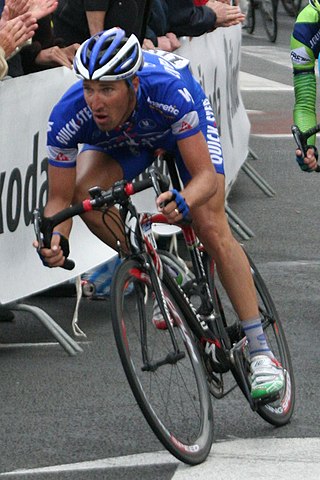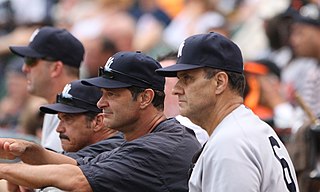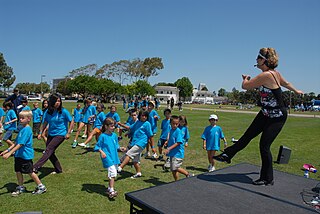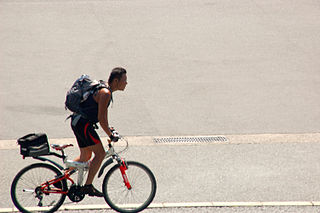
Exercise is physical activity that enhances or maintains fitness and overall health. It is performed for various reasons, including weight loss or maintenance, to aid growth and improve strength, develop muscles and the cardiovascular system, hone athletic skills, improve health, or simply for enjoyment. Many individuals choose to exercise outdoors where they can congregate in groups, socialize, and improve well-being as well as mental health.

Aerobic exercise is physical exercise of low to high intensity that depends primarily on the aerobic energy-generating process. "Aerobic" is defined as "relating to, involving, or requiring oxygen", and refers to the use of oxygen to meet energy demands during exercise via aerobic metabolism adequately. Aerobic exercise is performed by repeating sequences of light-to-moderate intensity activities for extended periods of time. Examples of cardiovascular or aerobic exercise are medium- to long-distance running or jogging, swimming, cycling, stair climbing and walking.

Creatine is an organic compound with the nominal formula (H2N)(HN)CN(CH3)CH2CO2H. It exists in various tautomers in solutions. Creatine is found in vertebrates where it facilitates recycling of adenosine triphosphate (ATP), primarily in muscle and brain tissue. Recycling is achieved by converting adenosine diphosphate (ADP) back to ATP via donation of phosphate groups. Creatine also acts as a buffer.

Sports drinks, also known as electrolyte drinks, are functional beverages whose stated purpose is to help athletes replace water, electrolytes, and energy before, during and especially after training or competition. The evidence is lacking pertaining to the efficacy of use of commercial sports drinks for sports and fitness performance.

Exercise physiology is the physiology of physical exercise. It is one of the allied health professions, and involves the study of the acute responses and chronic adaptations to exercise. Exercise physiologists are the highest qualified exercise professionals and utilise education, lifestyle intervention and specific forms of exercise to rehabilitate and manage acute and chronic injuries and conditions.
Birth order refers to the order a child is born in their family; first-born and second-born are examples. Birth order is often believed to have a profound and lasting effect on psychological development. This assertion has been repeatedly challenged. Recent research has consistently found that earlier born children score slightly higher on average on measures of intelligence, but has found zero, or almost zero, robust effect of birth order on personality. Nevertheless, the notion that birth-order significantly influences personality continues to have a strong presence in pop psychology and popular culture.

An athletic coach is a person coaching in sport, involved in the direction, instruction, and training of a sports team or athlete.

Stretching is a form of physical exercise in which a specific muscle or tendon is deliberately expanded and flexed in order to improve the muscle's felt elasticity and achieve comfortable muscle tone. The result is a feeling of increased muscle control, flexibility, and range of motion. Stretching is also used therapeutically to alleviate cramps and to improve function in daily activities by increasing range of motion.

Strength training, also known as weight training or resistance training, involves the performance of physical exercises that are designed to improve strength and endurance. It is often associated with the lifting of weights. It can also incorporate a variety of training techniques such as bodyweight exercises, isometrics, and plyometrics.
Bodybuilding supplements are dietary supplements commonly used by those involved in bodybuilding, weightlifting, mixed martial arts, and athletics for the purpose of facilitating an increase in lean body mass. Bodybuilding supplements may contain ingredients that are advertised to increase a person's muscle, body weight, athletic performance, and decrease a person's percent body fat for desired muscle definition. Among the most widely used are high protein drinks, pre-workout blends, branched-chain amino acids (BCAA), glutamine, arginine, essential fatty acids, creatine, HMB, whey protein, ZMA, and weight loss products. Supplements are sold either as single ingredient preparations or in the form of "stacks" – proprietary blends of various supplements marketed as offering synergistic advantages.
Confidence is the feeling of belief or trust that a person or thing is reliable. Self-confidence is trust in oneself. Self-confidence involves a positive belief that one can generally accomplish what one wishes to do in the future. Self-confidence is not the same as self-esteem, which is an evaluation of one's worth. Self-confidence is related to self-efficacy—belief in one's ability to accomplish a specific task or goal. Confidence can be a self-fulfilling prophecy, as those without it may fail because they lack it, and those with it may succeed because they have it rather than because of an innate ability or skill.

A pull-up is an upper-body strength exercise. The pull-up is a closed-chain movement where the body is suspended by the hands, gripping a bar or other implement at a distance typically wider than shoulder-width, and pulled up. As this happens, the elbows flex and the shoulders adduct and extend to bring the elbows to the torso.

The interplay of exercise and music has long been discussed, crossing the disciplines of biomechanics, neurology, physiology, and sport psychology. Research and experimentation on the relation between music and exercise dates back to the early 1900s, when investigator Leonard Ayres found that cyclists pedaled faster in the presence of a band and music, as opposed to when it was silent. Since then, hundreds of studies have been conducted on both the physiological and psychological relationship between music and physical activity, with a number of clear cut relationships and trends emerging. Exercise and music involves the use of music before, during, and/or after performing a physical activity. Listening to music while exercising is done to improve aspects of exercise, such as strength output, exercise duration, and motivation. The use of music during exercise can provide physiological benefits as well as psychological benefits.

Minimalist or barefoot shoes are intended to closely approximate barefoot running or walking conditions in comparison to traditional shoes. Minimalist shoes are defined as providing "minimal interference with the natural movement of the foot, because of its high flexibility, low heel to toe drop, weight and stack height, and the absence of motion control and stability devices." Minimalist shoes provide more sensory contact for the foot on the ground while simultaneously providing the feet with some protection from ground hazards and conditions. Research shows that wearing a minimalist shoe can help improve running economy, foot strength and arch function.
Father absence occurs when parents separate and the father no longer lives with his children and provides no parental investment. Parental separation has been proven to affect a child's development and behavior. Early parental divorce has been associated with greater internalizing and externalizing behaviors in the child, while divorce later in childhood or adolescence may dampen academic performance.
Stephen John Haake is a British sports engineer. He is professor of sports engineering at Sheffield Hallam University, England and is founding director of the university's advanced wellbeing research centre.
Velocity based training (VBT) is a modern approach to strength training and power training which utilises velocity tracking technology to provide rich objective data as a means to motivate and support real-time adjustments in an athlete's training plan. Typical strength and power programming and periodisation plans rely on the manipulation of reps, sets and loads as a means to calibrate training stressors in the pursuit of specific adaptations. Since the late 1990s, innovations in bar speed monitoring technology has brought velocity based training closer to the mainstream as the range of hardware and software solutions for measuring exercise velocities have become easier to use and more affordable. Velocity based training has a wide range of use cases and applications in strength and conditioning. These include barbell sports such as powerlifting and Olympic weightlifting and Crossfit, as well as rock climbing.Velocity based training is widely adopted across professional sporting clubs, with the data supporting many periodisation decisions for coaches in the weight room and on the field.
The Cogstate Brief Battery (CBB) is a computer-based cognitive assessment used in clinical trials, healthcare, and academic research to measure neurological cognition. It was developed by Cogstate Ltd.

Standing cycling or cycling out of the saddle is a form of cycling in which the rider stands up while applying force to the pedals.
The Nordic hamstring curl (NHC) is an exercise in which a person kneels with their feet fixed in position and lowers their body by extending the knee. It reduces hamstring injuries in athletes, and is commonly used as a form of injury prevention. NHC increases strength of the hamstrings and length of the fascia, sprint speed, and change of direction ability. It is debated whether NHC is an open or closed chain exercise. NHC has been compared to the razor hamstring curl.















